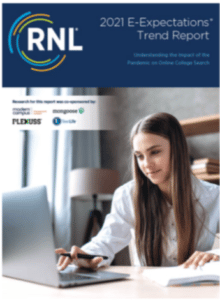Scaling AI Fluency for Marketing Teams: How ASU Leads with Innovation and Intent
See how ASU is leading AI fluency for marketing teams through leadership buy-in, innovation challenges, and custom tools that drive real, campus-wide impact.
Featured
Over the course of my career, I’ve had incredibly valuable experiences finding creative solutions for my higher ed clients.
Almost all of these creative solutions came through thoughtful, collaborative conversations.
It’s important for higher ed marketers to be constantly learning.
One of the best ways to continue growing your marketing skill set is to maintain healthy professional relationships that will challenge your way of thinking.

At first, we got a little nostalgic as we thought back to some of the early days of digital marketing.
But then we began to talk about some of those valuable lessons we’ve learned to keep ourselves sharp.

Part of Stephanie’s experience with the higher ed enrollment and fundraising agency Ruffalo Noel Levitz (RNL) was contributing to their highly regarded E-Expectations Trend Report.
The report dives into the insights gained from a national survey of high school sophomores, juniors, and seniors to learn their preferences and behaviors in regard to digital marketing.
In our conversation, Stephanie talked about her critical role in the development of the report, which has now become widely known throughout the higher ed community.
It was probably one of the most transformational opportunities I experienced while working for RNL. We were sitting around a conference table, as one does, and I was one of the younger consultants. Folks would turn to me and say, “Okay, what are these kids doing with the web these days?”
This was back in 2005. I had been doing a little bit of research myself [so I had some ideas]. We decided that we needed to create our own study.
This is something I loved about growing up in the RNL “lineage.” We were given the opportunity and encouraged to do research to benefit our client partners. With that ethos and leadership mindset, the idea of coming up with a research study was quickly pushed through.
Now it seems like a no-brainer to market to prospective students on the web or through other digital channels like websites, emails, and social media.
However, back then everything was brand-new.
The research Stephanie conducted along with her colleagues at RNL was invaluable for higher ed marketers like me who really saw the potential in digital marketing.
I created my first website in 1994.
I told my boss at the time, “Hey! Maybe this website thing has some legs and marketers should be doing it.”
He assured me it was a fad, and it wasn’t going anywhere.
I started working on college websites in 1998. By the early 2000’s (the early days of college websites) the RNL report was so valuable.
I remember telling people that students are going to be on the web. Trust me on that!
The E-Expectations Report really put the data and the facts behind it.
With all the changes happening in our field, how do you keep up?
How do you meet all the new challenges ahead?
For Stephanie Geyer, creative solutions come through collaborative, robust conversations with your team.
My advice is this: make time with your team for deep thinking.
Do it justice. Write on whatever you need to write on and do something with those notes immediately afterwards.
Give people a chance to really tune in on a concept, or a problem, or an opportunity.
Everything’s okay, just [let them] get it all out there. Let it be squirrely.
Here’s another bit of advice: If it happens to be March, you definitely should go to McDonald’s and get a shamrock shake – or 15 of them! – and as many chicken nuggets as you can carry.
Then you will have very willing happy participants in your exercise.
It’s always a tough sell to get people out to yet another meeting.
Especially if you need a couple hours of brainstorming and dialogue.
But this is how creative solutions find their way to the surface.
In fact, Stephanie is still using the creative solutions that she gained back in the 90’s through these deep-thinking conversations with her mentors and colleagues.
I was just on campus a couple of weeks ago, and I was doing this deep-thinking exercise with my team.
[As I led the exercise], I was drawing on conversations that I had with Charlie Hutchins, who was the fabled higher ed consultant for many years.
The things Charlie taught me in 1994 are still right and true and valuable to new professionals who are coming in and trying to learn how to market to prospective students.
So certainly, the tactics and channels we use are really different, but the foundational pieces are still holding me up.
Like all of our blog post reviews of The Higher Ed Marketer podcasts, there’s so much more to learn in the podcasts themselves.
Listen to our interview with Stephanie Geyer to get even more insights into:
Then you’ve got to know how to write for the web. That’s why we want to send you our popular ebook: Writing for the Web: 7 Secrets to Content Marketing Success for Education Marketers!
With this helpful resource, you’ll learn how to:
In short, you’ll be able to write the copy that makes your digital marketing strategy work for you. Download your copy today!
Featured image via umt.edu
Stephanie Geyer image via Twitter
Ruffalo Noel Levitz image via ruffalonl.com
Subscribe to The Higher Ed Marketer podcast today!